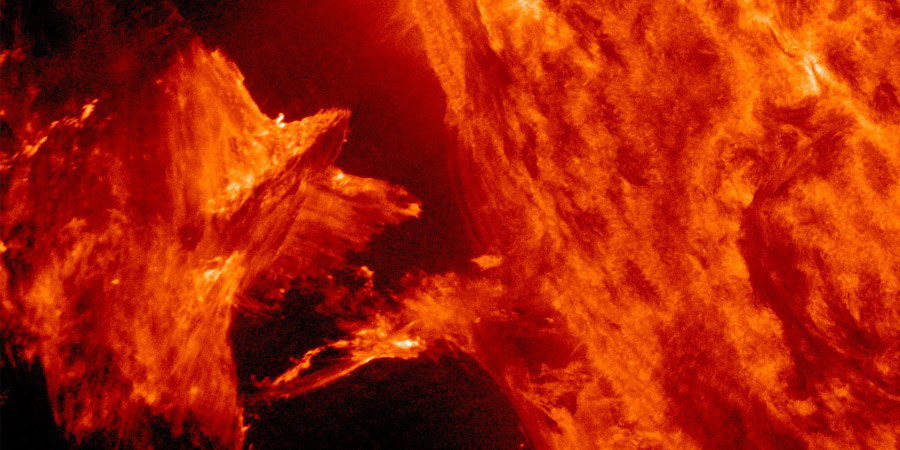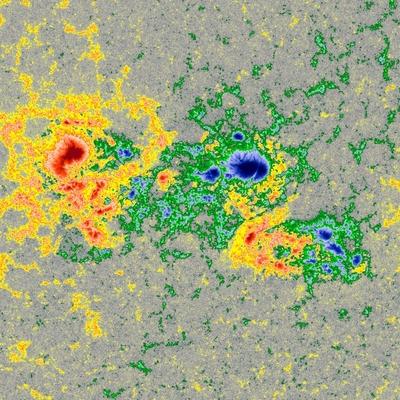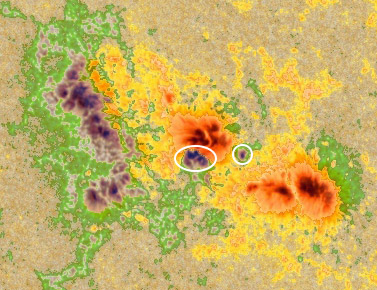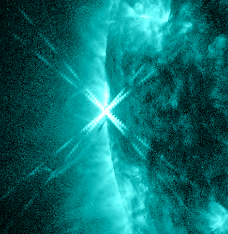SpaceWeatherLive update
Saturday, 27 September 2014 08:21 UTC

A large update today as there is a lot to talk about right now. We haven't seen any M-class solar flares since last Tuesday but that can not last long with the sunspot regions currently on the disk. We also take a look at some far side fireworks from a sunspot region that is hiding just behind the east-limb and we talk about the geomagnetic conditions at Earth.
Sunspot region 2172
Sunspot region 2172 continues to evolve and change. It right now has a Bèta-Gamma (A bipolar sunspot group but complex enough so that no line can be drawn between spots of opposite polarity) magnetic layout with a solid ammount of magnetic mixing as can be seen below on this image from NASA SDO. Note how the blue and red sunspot are mixed. None of them however are so close together that we can speak of any delta magnetic layouts. A low-level M-class flare (R1) can not be excluded.

A thing to note is that sunspot region 2173 is expanding as well and is located closely near sunspot region 2172. This should be monitered as well as these sunspot regions might start to interact with eachother if they come any closer. Sunspot region 2173 itself is still a sunspot region with a Beta magnetic layout but it is in a stage of development. If any of these sunspot regions erupt than there is a good chance that it launches an earth-directed coronal mass ejection.
Images: NASA SDO/HMI.
Sunspot region 2175
The sunspot region that we really need to look out for listens to the name 2175. This sunspot region has a clear Bèta-Gamma-Delta magnetic layout right in the center of the sunspot group. The most western delta is borderline delta and could break lose. This is however not the delta of interest. Just south of the intermediate spot is there where we find something interesting. There we find a large delta structure packed closely to the spots of opposite polarity. This sunspot region has the potential to produce a strong M-class solar flare (R1-R2) today.
Image: NASA SDO.
East limb eruption
Another solar event that we can't leave unnoticed is a spectaculair eruption just behind the east-limb as seen from Earth. Massive amounts of plasma can be seen shooting of into space on SDO, STEREO and coronagraph imagery from SOHO. This eruption seems to be a result of a solar flare just behind the east-limb as seen from Earth. This region might be old sunspot region 2157 which was responsible for two M-class solar flares when it was on the earth-facing disk last time. It should become visible from Earth's point of view in the next 24 to 48 hours.

Image: NASA STEREO Behind.
Video: NASA SDO and ESA/NASA SOHO.
Header image: NASA SDO.
Geomagnetic conditions
Geomagnetic conditions at Earth remain elevated thanks to continued coronal hole influences. The direction of the IMF remains mostly south and enhanced auroral displays are reported from high latitudes. Be alert in the coming days for enhanced auroral activity as coronal hole high speed stream effects persist. Kp-values up to 4 (active conditions) remain possible.

Image: The Kp-index as a global aurora indicator
M1 solar flare (ADDED 14:42 UTC)
Solar activity actually increased to moderate levels today thanks to an M1 solar flare during the GOES eclipse at 08:37 UTC. The source of this event appears to have originated from a region just behind the east limb near the equator. The event was impulsive and likely did not produce a coronal mass ejection. Even if there is a coronal mass ejection associated with this event, it will be directed away from Earth. There looks to be at least one interesting sunspot region hiding behind the east limb!
Image: NASA SDO. Special thanks goes to Tomasz Mielec for pointing out this event.
Thank you for reading this article! Did you have any trouble with the technical terms used in this article? Our help section is the place to be where you can find in-depth articles, a FAQ and a list with common abbreviations. Still puzzled? Just post on our forum where we will help you the best we can!
Latest news
Latest forum messages
Support SpaceWeatherLive.com!
A lot of people come to SpaceWeatherLive to follow the Sun's activity or if there is aurora to be seen, but with more traffic comes higher server costs. Consider a donation if you enjoy SpaceWeatherLive so we can keep the website online!

Space weather facts
| Last X-flare | 2024/12/08 | X2.2 |
| Last M-flare | 2024/12/23 | M8.9 |
| Last geomagnetic storm | 2024/12/17 | Kp5+ (G1) |
| Spotless days | |
|---|---|
| Last spotless day | 2022/06/08 |
| Monthly mean Sunspot Number | |
|---|---|
| November 2024 | 152.5 -13.9 |
| December 2024 | 106.6 -45.9 |
| Last 30 days | 116.1 -41.8 |



